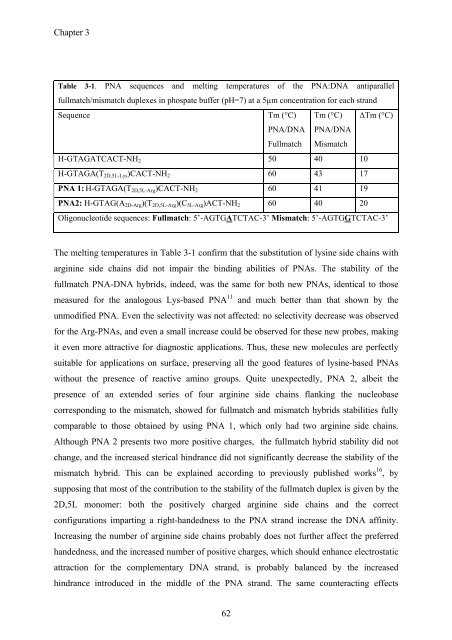View - DSpace UniPR
View - DSpace UniPR
View - DSpace UniPR
Create successful ePaper yourself
Turn your PDF publications into a flip-book with our unique Google optimized e-Paper software.
Chapter 3<br />
Table 3-1. PNA sequences and melting temperatures of the PNA:DNA antiparallel<br />
fullmatch/mismatch duplexes in phospate buffer (pH=7) at a 5µm concentration for each strand<br />
Sequence<br />
Tm (°C) Tm (°C) ΔTm (°C)<br />
PNA/DNA<br />
Fullmatch<br />
PNA/DNA<br />
Mismatch<br />
H-GTAGATCACT-NH 2 50 40 10<br />
H-GTAGA(T 2D,5L-Lys )CACT-NH 2 60 43 17<br />
PNA 1: H-GTAGA(T 2D,5L-Arg )CACT-NH 2 60 41 19<br />
PNA2: H-GTAG(A 2D-Arg )(T 2D,5L-Arg )(C 5L-Arg )ACT-NH 2 60 40 20<br />
Oligonucleotide sequences: Fullmatch: 5’-AGTGATCTAC-3’ Mismatch: 5’-AGTGGTCTAC-3’<br />
The melting temperatures in Table 3-1 confirm that the substitution of lysine side chains with<br />
arginine side chains did not impair the binding abilities of PNAs. The stability of the<br />
fullmatch PNA-DNA hybrids, indeed, was the same for both new PNAs, identical to those<br />
measured for the analogous Lys-based PNA 11 and much better than that shown by the<br />
unmodified PNA. Even the selectivity was not affected: no selectivity decrease was observed<br />
for the Arg-PNAs, and even a small increase could be observed for these new probes, making<br />
it even more attractive for diagnostic applications. Thus, these new molecules are perfectly<br />
suitable for applications on surface, preserving all the good features of lysine-based PNAs<br />
without the presence of reactive amino groups. Quite unexpectedly, PNA 2, albeit the<br />
presence of an extended series of four arginine side chains flanking the nucleobase<br />
corresponding to the mismatch, showed for fullmatch and mismatch hybrids stabilities fully<br />
comparable to those obtained by using PNA 1, which only had two arginine side chains.<br />
Although PNA 2 presents two more positive charges, the fullmatch hybrid stability did not<br />
change, and the increased sterical hindrance did not significantly decrease the stability of the<br />
mismatch hybrid. This can be explained according to previously published works 16 , by<br />
supposing that most of the contribution to the stability of the fullmatch duplex is given by the<br />
2D,5L monomer: both the positively charged arginine side chains and the correct<br />
configurations imparting a right-handedness to the PNA strand increase the DNA affinity.<br />
Increasing the number of arginine side chains probably does not further affect the preferred<br />
handedness, and the increased number of positive charges, which should enhance electrostatic<br />
attraction for the complementary DNA strand, is probably balanced by the increased<br />
hindrance introduced in the middle of the PNA strand. The same counteracting effects<br />
62
















